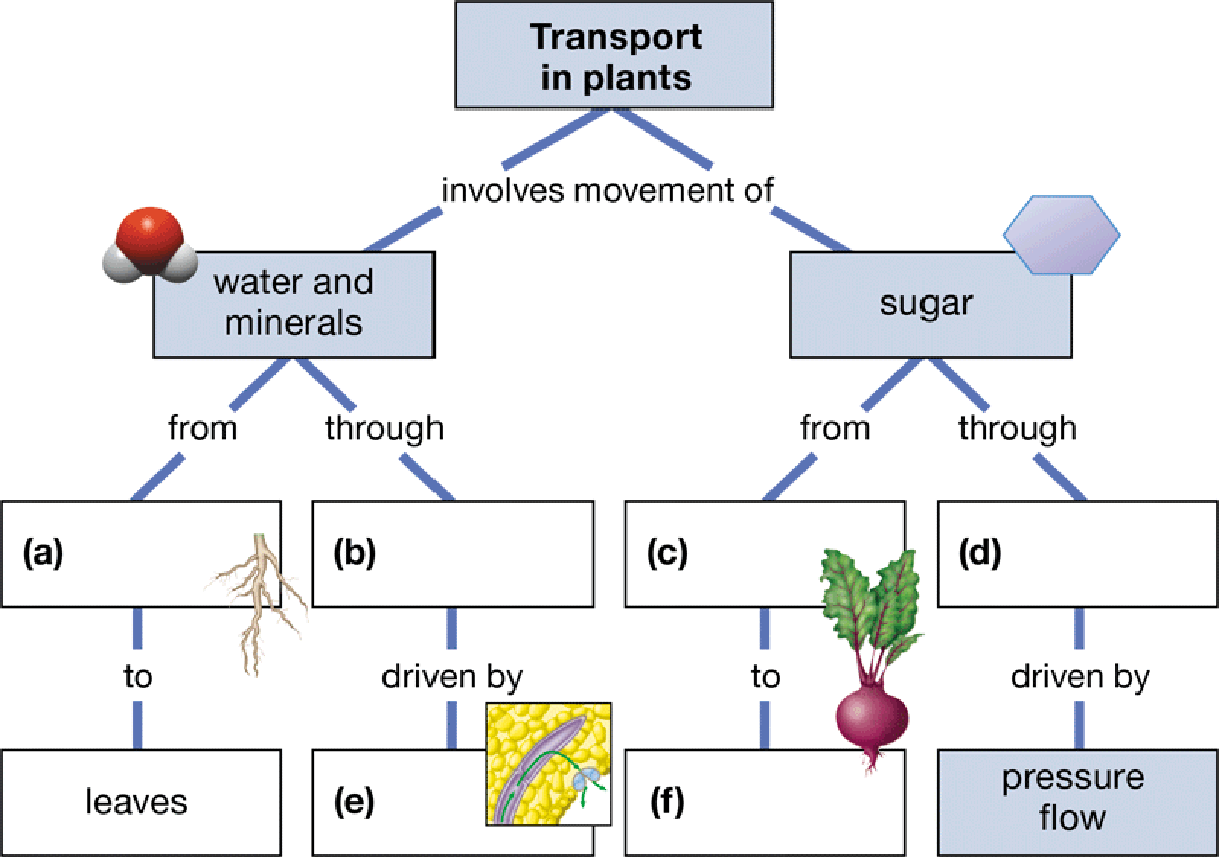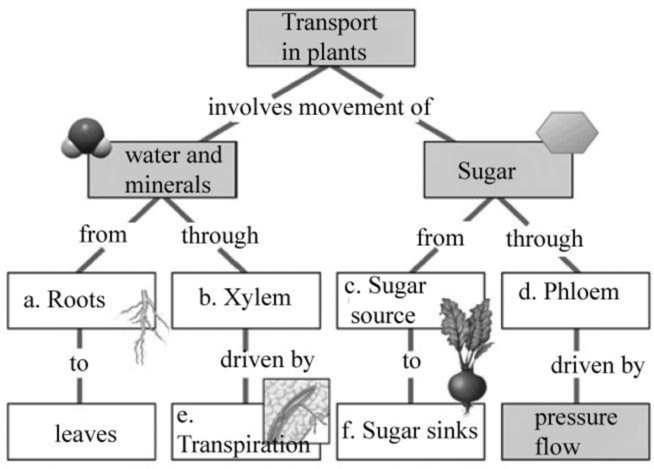
Fill in the blanks in this concept map to help you tie together key concepts concerning transport in plants.

To create: The concept map that depicts transportation in plant.
Introduction: Angiosperms are the most developed group in the plant kingdom. They comprise the root system, root hairs, shoot system, leaves, petioles, blades, stems, nodes, internodes, and flower. They are seed-bearing plants that are covered.
Explanation of Solution
Pictorial representation: Fig: 1 shows a complete concept map of transport in plants.

Figure 1: The concept map depicting the concept in transport in plants.
(a)
Correct answer: Roots.
Roots are the part of the root system that helps in uptake of water and minerals from the surrounding to the shoot system. Hence, the correct answer is roots.
(b)
Correct answer: Xylem.
Xylem is the vascular bundles present in the inner region of the stem that sends water and minerals through them to the rest of the plant body. Hence, the correct answer is xylem.
(c)
Correct answer: Sugar source.
Sugar source is the leaves where, by the process of photosynthesis, the sugar is made. Hence, the correct answer is sugar source.
(d)
Correct answer: Phloem.
Phloem is a type of vascular bundle through which the sugar sources are transported to the rest of the plant body. Hence, the correct answer is phloem.
(e)
Correct answer: Transpiration.
It is the process of loss of water from the plant through the leaves. This helps in maintaining the osmotic balance. Hence, the correct answer is transpiration.
(f)
Correct answer: Sugar sinks.
It is the region where the prepared sugar is stored till the plant is in requirement of energy. When such a situation arises, the plant supplies the sugar from these stored regions. Hence, the correct answer is sugar sinks.
Want to see more full solutions like this?
Chapter 32 Solutions
CAMPBEL BIOLOGY:CONCEPTS & CONNECTIONS
- Amino Acid Coclow TABle 3' Gly Phe Leu (G) (F) (L) 3- Val (V) Arg (R) Ser (S) Ala (A) Lys (K) CAG G Glu Asp (E) (D) Ser (S) CCCAGUCAGUCAGUCAG 0204 C U A G C Asn (N) G 4 A AGU C GU (5) AC C UGA A G5 C CUGACUGACUGACUGAC Thr (T) Met (M) lle £€ (1) U 4 G Tyr Σε (Y) U Cys (C) C A G Trp (W) 3' U C A Leu בוט His Pro (P) ££ (H) Gin (Q) Arg 흐름 (R) (L) Start Stop 8. Transcription and Translation Practice: (Video 10-1 and 10-2) A. Below is the sense strand of a DNA gene. Using the sense strand, create the antisense DNA strand and label the 5' and 3' ends. B. Use the antisense strand that you create in part A as a template to create the mRNA transcript of the gene and label the 5' and 3' ends. C. Translate the mRNA you produced in part B into the polypeptide sequence making sure to follow all the rules of translation. 5'-AGCATGACTAATAGTTGTTGAGCTGTC-3' (sense strand) 4arrow_forwardWhat is the structure and function of Eukaryotic cells, including their organelles? How are Eukaryotic cells different than Prokaryotic cells, in terms of evolution which form of the cell might have came first? How do Eukaryotic cells become malignant (cancerous)?arrow_forwardWhat are the roles of DNA and proteins inside of the cell? What are the building blocks or molecular components of the DNA and proteins? How are proteins produced within the cell? What connection is there between DNA, proteins, and the cell cycle? What is the relationship between DNA, proteins, and Cancer?arrow_forward
- please fill in the empty sports, thank you!arrow_forwardIn one paragraph show how atoms and they're structure are related to the structure of dna and proteins. Talk about what atoms are. what they're made of, why chemical bonding is important to DNA?arrow_forwardWhat are the structure and properties of atoms and chemical bonds (especially how they relate to DNA and proteins).arrow_forward
- The Sentinel Cell: Nature’s Answer to Cancer?arrow_forwardMolecular Biology Question You are working to characterize a novel protein in mice. Analysis shows that high levels of the primary transcript that codes for this protein are found in tissue from the brain, muscle, liver, and pancreas. However, an antibody that recognizes the C-terminal portion of the protein indicates that the protein is present in brain, muscle, and liver, but not in the pancreas. What is the most likely explanation for this result?arrow_forwardMolecular Biology Explain/discuss how “slow stop” and “quick/fast stop” mutants wereused to identify different protein involved in DNA replication in E. coli.arrow_forward
 Biology (MindTap Course List)BiologyISBN:9781337392938Author:Eldra Solomon, Charles Martin, Diana W. Martin, Linda R. BergPublisher:Cengage Learning
Biology (MindTap Course List)BiologyISBN:9781337392938Author:Eldra Solomon, Charles Martin, Diana W. Martin, Linda R. BergPublisher:Cengage Learning Biology: The Dynamic Science (MindTap Course List)BiologyISBN:9781305389892Author:Peter J. Russell, Paul E. Hertz, Beverly McMillanPublisher:Cengage Learning
Biology: The Dynamic Science (MindTap Course List)BiologyISBN:9781305389892Author:Peter J. Russell, Paul E. Hertz, Beverly McMillanPublisher:Cengage Learning Biology 2eBiologyISBN:9781947172517Author:Matthew Douglas, Jung Choi, Mary Ann ClarkPublisher:OpenStax
Biology 2eBiologyISBN:9781947172517Author:Matthew Douglas, Jung Choi, Mary Ann ClarkPublisher:OpenStax- Basic Clinical Lab Competencies for Respiratory C...NursingISBN:9781285244662Author:WhitePublisher:Cengage






